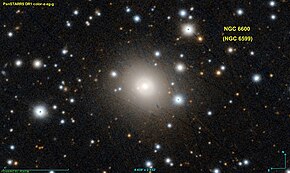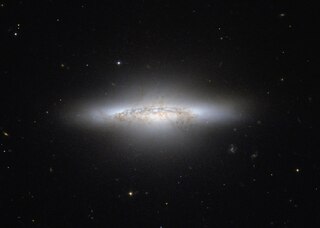
NGC 5010 is a lenticular galaxy located about 140 million light years away in the constellation Virgo. It was discovered by John Herschel on May 9, 1831. It is considered a Luminous Infrared Galaxy (LIRG). As the galaxy has few young blue stars and mostly red old stars and dust, it is transitioning from being a spiral galaxy to being an elliptical galaxy, with its spiral arms having burned out and become dusty arms. From the perspective of Earth, the galaxy is facing nearly edge-on.

LEDA 83677 is a lenticular galaxy located about 290 million light-years away in the constellation Coma Berenices. It is a member of the Coma cluster of galaxies. LEDA 83677 is also classified as a type 1 Seyfert galaxy. The core of the galaxy is emitting high-energy X-rays and ultraviolet light, probably caused by a massive black hole lurking in the core.

NGC 1510 is a dwarf lenticular galaxy approximately 38 million light-years away from Earth in the constellation of Horologium. It was discovered by John Herschel on December 4, 1836.

NGC 505 is a lenticular galaxy approximately 234 million light-years away from Earth in the constellation of Pisces. It was discovered by German astronomer Albert Marth on October 1, 1864.

NGC 966 is an unbarred lenticular galaxy approximately 440 million light-years away from Earth in the constellation of Cetus. It was discovered by American astronomer Francis Preserved Leavenworth in 1886.

NGC 1190 is a lenticular galaxy approximately 109 million light-years away from Earth in the constellation of Eridanus. It was discovered by American astronomer Francis Leavenworth on December 2, 1885 with the 26" refractor at Leander McCormick Observatory.

NGC 1191 is a lenticular galaxy approximately 406 million light-years away from Earth in the constellation of Eridanus. It was discovered by American astronomer Francis Leavenworth on December 2, 1885 with the 26" refractor at Leander McCormick Observatory.
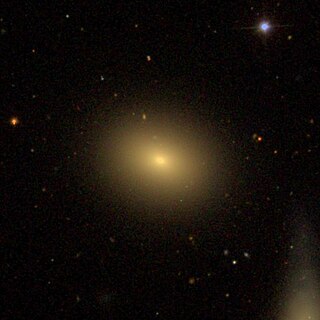
NGC 4551 is an elliptical galaxy located about 70 million light-years away in the constellation Virgo. It was discovered by astronomer William Herschel on April 17, 1784. NGC 4551 appears to lie close to the lenticular galaxy NGC 4550. However, both galaxies show no sign of interaction and have different red shifts. Both galaxies are also members of the Virgo Cluster.

NGC 6028 is a barred lenticular galaxy and a ring galaxy located about 200 million light-years away in the constellation Hercules. Ring galaxies such as NGC 6028 are also known as Hoag-type galaxies as they may have a resemblance to the prototype, Hoag's Object. NGC 6028 was discovered by astronomer William Herschel on March 14, 1784. It was then rediscovered by astronomer Guillaume Bigourdan on May 4, 1886.

NGC 6039 is a massive lenticular galaxy located about 460 million light-years away in the constellation Hercules. NGC 6039 was discovered by astronomer Édouard Stephan on June 27, 1870 and later rediscovered by astronomer Lewis Swift on June 27, 1886. NGC 6039 is member of the Hercules Cluster, which is part of the CfA2 Great Wall.

NGC 6040 is a spiral galaxy located about 550 million light-years away in the constellation Hercules. NGC 6040 was discovered by astronomer Édouard Stephan on June 27, 1870. NGC 6040 is interacting with the lenticular galaxy PGC 56942. As a result of this interaction, NGC 6040's southern spiral arm has been warped in the direction toward PGC 56942. NGC 6040 and PGC 56942 are both members of the Hercules Cluster.
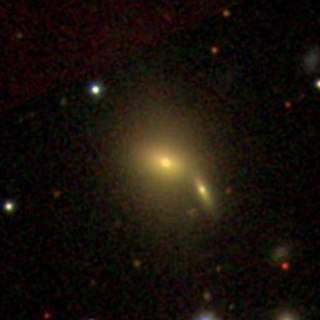
NGC 6043 is a lenticular galaxy located about 444 million light-years away in the constellation Hercules. NGC 6043 was discovered by astronomer Lewis Swift on June 27, 1886. The galaxy is a member of the Hercules Cluster.

NGC 6044 is a lenticular galaxy located about 465 million light-years away in the constellation Hercules. NGC 6044 was discovered by astronomer Lewis Swift on June 27, 1886. It was then rediscovered by astronomer Guillaume Bigourdan on June 8, 1888. NGC 6044 is a member of the Hercules Cluster.
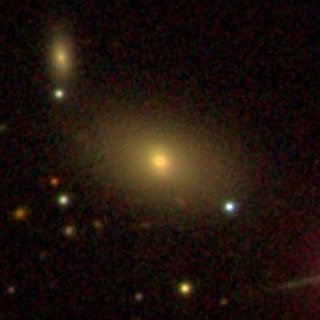
NGC 6054 is a barred lenticular galaxy located about 460 million light-years away in the constellation Hercules. It was discovered by astronomer Lewis Swift on June 27, 1886. It was then rediscovered by astronomer Guillaume Bigourdan on June 1, 1888. PGC 57073 is often misidentified as NGC 6054. NGC 6054 is a member of the Hercules Cluster.
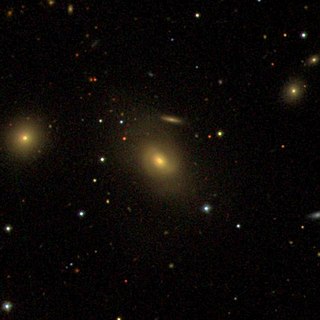
NGC 6055 is a barred lenticular galaxy located about 450 million light-years away in the constellation Hercules. The galaxy was discovered by astronomer Lewis Swift on June 8, 1886. It also a member of the Hercules Cluster and is a LINER galaxy.

NGC 6061 is a lenticular galaxy with radio activity located about 490 million light-years away in the constellation Hercules. The galaxy is classified as a head-tail radio galaxy and was discovered by astronomer Lewis Swift on June 8, 1886. NGC 6061 is a member of the Hercules Cluster.

NGC 676 is a lenticular Seyfert 2 galaxy about 18.7 Mly away in the constellation Pisces. It can be seen near the star α Piscium. Located close to the celestial equator, it is visible from both hemispheres. BD +04 0244, a star with a visual magnitude of 10.44, is superposed 5.1 arc seconds south-southwest of the nucleus. It is one of the 621 galaxies described in Marat Arakelian's catalog of high-surface-brightness galaxies.
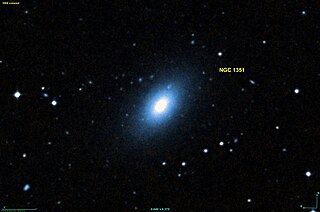
NGC 1351 is a lenticular galaxy in the constellation Fornax. It has a redshift of z=0.00505, and its distance from Earth can be estimated as 21 million parsecs. It is elongated in shape, and was discovered by William Herschel on October 19, 1835.

NGC 6261 is a lenticular galaxy in the constellation of Hercules. It is located 470 million light-years away from the Solar System and has an approximate diameter of 200,000 light-years.

IC 1189 is a S0-a lenticular galaxy with a ring structure located in Hercules. It is located 557 million light-years away from the Solar System and has an approximate diameter of 145,000 light-years. IC 1189 was discovered on June 7, 1888, by Lewis Swift. It is a member of the Hercules Cluster.
